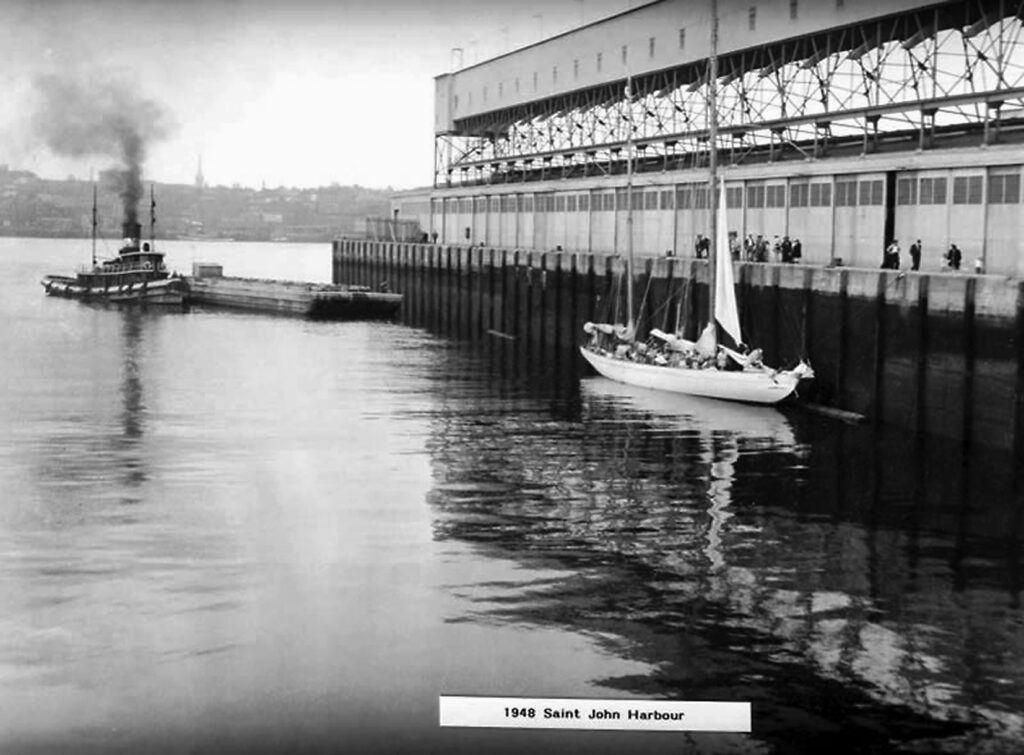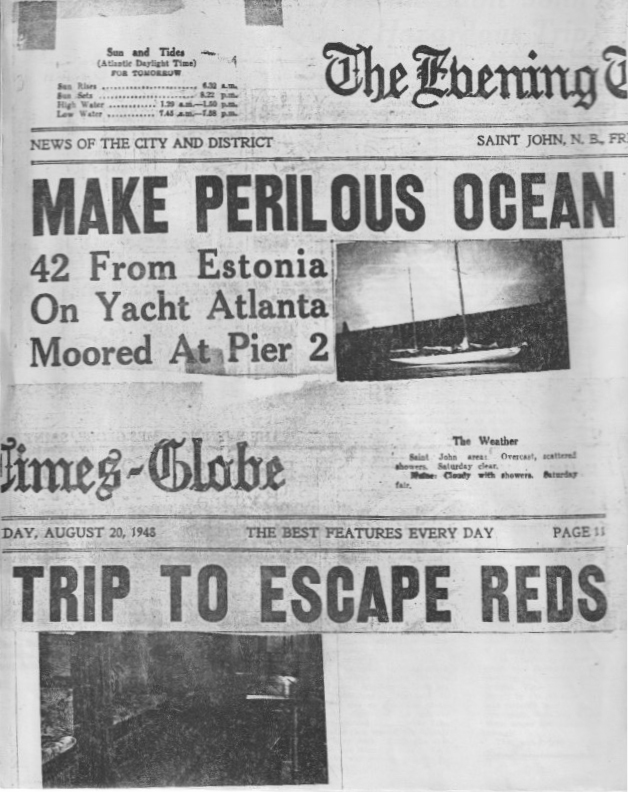Boats

Atlanta i hamnen i Saint John.
Atlanta
Atlanta var den andra baltiska flyktingbåten som nådde Kanada. Båten påbörjade sin resa i Lysekil, 19 juni 1948, med 42 ester ombord, bland dem fyra barn. Två månader senare, efter en 9700 kilometer lång resa, lade den 26 meter långa, tvåmastade lyxketchen till i hamnen i Saint John, Kanada, 10 augusti 1948.
Under hösten 1947 köpte Kalju Pullerits, som organiserade resan, den 60 ton tunga yachten för 70 000 svenska kronor. Båten hade byggts i Sverige 1898 och använts av svenska sjökadetter för träning. Varje flykting betalade 4000 kr för passagen, vilket inkluderade mat och andra kostnader ombord. Atlantas kapten var Eugen Kommissar, en erfaren sjömän som hade tagit examen från Tallinns sjöfartsskola 1944.
Svenska myndigheter hade tillåtit Atlanta att lämna Lysekil för en nöjesresa. Passagerare tilläts ta med sig två resväskor var, och de hade med sig medicinska certifikat men inga kanadensiska visum. Den 19 juni, började resan i soligt väder men efter bara några dagar seglade båten in i en storm och var tvungen att söka skydd nära Kristiansand i Norge. Den 22 juni kunde yachten fortsätta sin färd, men var tvungen att navigera förbi ett orensat minfält och fastnade i fiskenät. Den 29 juni nådde båten Portland Royal Naval Base i Dorset, England. Kapten Kommissaar var bekant med basen eftersom estniska ubåtar hade tränat där under 1937.
7 juli fortsatte Atlanta söderut, korsade Biscayabukten utan problem och seglade vidare nerför den spanska och portugisiska kusten, och vände 13 juli mot Kanarieöarna. Yachten anlände till Las Palmas 18 juli, men tilläts inte lägga till så handelsmän förde ut frukt och vatten till skeppet. 19 juli påbörjade Atlanta sin långa resa över Atlanten, följandes samma passadvindar som ledde Christopher Columbus 500 år tidigare.
Passageraren Elise Lige återberättade resan i en intervju år 1985: “Vågorna var lika höga som en 20-våningsbyggnad, havet och himlen tycktes oändliga och pågick i veckor. Under klara, varma nätter var himlen täckt av stjärnor, och vattnet glittrade som diamanter. Människor sov på däck eller inte alls. Soluppgången var lika vacker, och en ytterligare höjdpunkt på morgonen var delfinerna och fiskarna som simmade förbi.” Vid ett tillfälle lyckades Elise Life undvika tragedi genom att fånga Ernst Laur i fötterna då han höll på att trilla överbord när han fyllde en hink med vatten.
Då yachten nått Bermuda, hade en av vattentankarna börjat läcka och till slut tömts helt. Kapten Kommissar bestämde att de skulle segla till Bermuda för att skaffa mer vatten, men besättningen hade inte exakta sjökort för området. Atlanta gick på grund på ett undervattensrev, men räddades av en storm som fick lös båten. Med hajar som cirkulerade båten bestämde sig passagerarna för att strunta i Bermuda och istället segla till Kanada. Trots de starka vindarna och höga vågorna var seglingsförhållandena generellt gynnsamma. För att hantera bristen på dricksvatten, samlade passagerarna ihop regnvatten som rann nerför seglen och i kastruller under hårda regnfall.
19 augusti anlände Atlanta i Saint John, New Brunswick, Kanada. Den kanadensiska kustvakten antog att de var rika amerikaner ombord fram tills de mötte de hungriga, törstiga och solbrända estniska flyktingarna. De togs i land och tillbringade en månad på Lancaster sjukhus för att genomgå medicin- och säkerhetskontroller. Under tiden i förvar, mottog vissa passagerare, bland annat Kalju Pullerits, utvisningsbeslut, som dock senare upplöstes. 1995 skrev han ett brev om sin upplevelse:
“Mina universitetsstudier hade avbrutits av krig, och vi var utan pengar när vi anlände i Saint John. Migrationsmyndigheten utfärdade utvisningsbeslut med utlåtande att vi med största sannolikhet skulle hållas av staten och inte hade tillräckligt med medel för att försörja oss själva. Medan Atlanta fortfarande var i hamnen förberedde vi oss för avfärd till Argentina eftersom återvändande till födelseland, enligt migrationslagen, betydde säker död för oss alla. Slutligen var vi accepterade och tilläts stanna, och vi reste med tåg, betalt för av kanadensiska Röda korset, till Montreal och största delen av båtfamiljen till Toronto.”
[Canadian Museum of Immigration at Pier 21]
I slutändan tillät den kanadensiska regeringen alla Atlantas passagerare att stanna i Kanada.
Vad hände med Atlanta?
Atlanta såldes till en affärsman i Saint John för 5000 kanadensiska dollar, en bråkdel av de motsvarande 35,000 kanadensiska dollar esterna hade betalat för den. Yachten blev dock inte omhändertagen ordentligt och slutade upp strandad i Indiantown, New Brunswick. 1964 köpte Don Hartt det havererade skrovet, återställde det och seglade med båten i Karibien. 1975 såldes båten igen, och de nya ägarna tog med den till Toronto, där 21 av de estniska flyktingarna återförenades ombord. Yachten började göra dagskryssningar kring Toronto men under sommaren 1976 gick den på grund nära hamnen i Kingston och efter en tid bogserades vraket till land.

“Farlig sjöresa för att fly från de röda,” The Evening Times-Globe, New Brunswick, Kanada, 20 augusti 1948.
Kända besättningsmedlemmar och passagerare:
- Kapten Eugen Kommissar, fru Maimo och dotter Malle
- Kalju Pullerits från Karula med fru Aino från Tallinn
- Andrei Vool från Häädemeeste
- Alfred och Adele Kelberg från Dagö
- Siegfried Polli från Koita med fru Nadja Aste från Kuressaare
- Valentin Aas från Hellamaa, fru Elise Pauli från Kuusalu och son Ivo
- Leida Rohtla från Albu
- Elmar Huberg Hapsal, fru Leida och son Peet
- Karl Aaspere från Tallinn
- Adele Kask från Puurmann
- Marta Sepp från Kaarmaa
- Ernst Laur från Allik
- Anastasia Sepp från Ösel
- Leonard Aidamets från Ösel
- Lydia och Victor Sild från Võisikt
- August Nõmme från Tila
- Arved Liideman från Paikus
- Priidik Seppel från Hapsal
- Julia Viilu från Ösel
- Rudolf Müid från Emmaste
- Evald Engman från Nuckö
- Leander och Ella Üksik från Nuckö
- Erika Nõmme från Narva
- Vladimir Sepp och son Tarmo från Ösel
- Edvard och Helme Kaju från Emmaste
- Pauline Eigi från Hapsal
- Arnold Pflug från Tapa
- Arnold Rae från Virumaa
- Silvi Sadul från Dagö
- Elise Lige
Fotografi använt med tillåtelse från Estniska sjöfartsmuseet.
